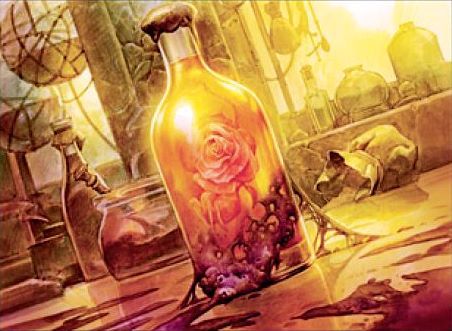
Art by Zoltan Boros & Gabor Szikszai
I’ve written a great deal about Constructed play in Magic: the Gathering, but it isn’t the only format out there. While everything from Standard to Commander falls under the Constructed umbrella, there are other ways to play the game that don’t involve spending a great deal of time before an event putting a deck together. The other way to play is Limited, so called because you are given a limited number of cards to work with at the start and must build from there within a limited amount of time.
Back when I first started playing, you could get generic Starter Decks of Magic that contained semi-randomized decks of cards. In those days, Sealed events consisted of you getting one of these, plus a couple boosters, and building a deck from there based on what you opened. Nowadays, there are Intro and Event decks that all have pre-determined sets of cards within. This allows for too much foreknowledge, and takes away some of the appeal of the event, as the mystery of what you’ll open and how you can use it to win is part of the fun. So, if you play a Sealed event today, it’d be with six boosters.
However, you at least get to keep all of the cards you open in Sealed. This is not the case in Draft. You only get three boosters when you draft, and the nuances don’t stop there. You open your first pack with the rest of the people at your table, look at the cards you’ve opened, choose one, and pass the rest to your neighbor. You, in turn, get your other neighbor’s cards, choose one from them, and so on. You end up with the same amount of cards that you open – 45 – but you chose each and every one of them. Instead of being able to determine a theme or a course of action for the deck within the generous time allowed for Sealed, you do so in real time during Draft.
Either way, the only thing you can know before going into a Limited event is what to look for in your packs. You can have a favorite color combination, card type, or particular single to look for, sure, but you’re going to have to play with what you’ve got in front of you. So how do you make the most of it?
One answer is a simple acronym: BREW.
Basically, BREW is a system that prioritizes the cards you get and helps you keep in mind things to look for that will support whatever deck you end up building. It’s especially helpful in Draft, as your first card falling into one of these categories (usually the first two) will help narrow down your color choices. Sometimes. Anyway, let’s break this down.
Bombs
First and foremost you want to look for finishers. Every deck needs ways to win, and since you know you’re going to end up with at least a few low-cost creatures to hold off early aggression (or put some pressure on yourself!), finding the coup de grace is a higher priority. This is especially true since some (but not all) true finishers are rares. Also, not all of them are creatures: a well-timed [mtg_card]Rakdos’ Return[/mtg_card] or [mtg_card]Fireball[/mtg_card] can end your opponent’s game just as much as a titanic monster.
Removal
You want to keep an opponent’s threats from harming you. The best way to do this is to keep them off the table entirely, which is where removal comes in. A lot of this comes in the form of direct damage like [mtg_card]Annihilating Fire[/mtg_card] or focused destruction cards such as [mtg_card]Avenging Arrow[/mtg_card] but it’s also worth noting that some removal takes the form of enchantments like [mtg_card]Arrest[/mtg_card] and temporary states such as those caused by the Detain mechanic. You’ll tend to find more removal than bombs in a given Limited set, so they’re what we look for next.
Evasion
Remember those non-bomb creatures I mentioned? Most of them are going to be walking around on the ground. If you want to damage your opponent, you’re going to need to avoid them, go right through them, or use yours to hold off the bad guys while your guys remain safe. That, in a nutshell, is evasion. An evasive creature is one that either gets around the enemy or makes attacking unattractive. A good example is flight: a card that flies on its own such as [mtg_card]Tower Drake[/mtg_card] or a card that grants flight, [mtg_card]Pursuit of Flight[/mtg_card] for example, are both viable evasion tactics. Unblockable creatures such as [mtg_card]Invisible Stalker[/mtg_card] are a given, as is anything with a landwalking ability. Creatures with First Strike are also technically evasive: they do their damage without taking any themselves, provided they’re beefy enough to take out whatever they’re facing. I’m sure you can think of other examples.
Whatever
If you can’t find any bombs, removal, or evaders at this point, just grab whatever supports the deck. Mana dorks, Defenders, cards that accelerate your drawing, etc. In Draft, it’s important to keep in mind you may not use everything you pick, so you can pick things you’ll never actually play just to keep an opponent from using them. This is called “hate drafting” and Evil Steve Sadin discusses it here.
Those are the basics of Limited construction, and I’ll give you a more concrete example soon, as well as giving you a run down on how to draft at 4 am on a Tuesday rather than waiting for your friendly local gaming store to hold an event.

